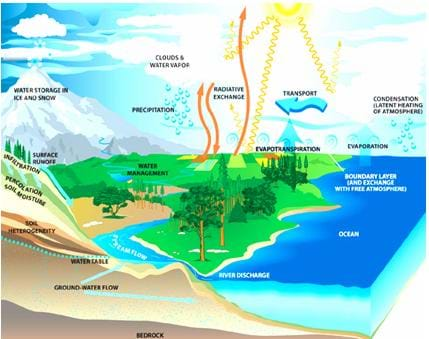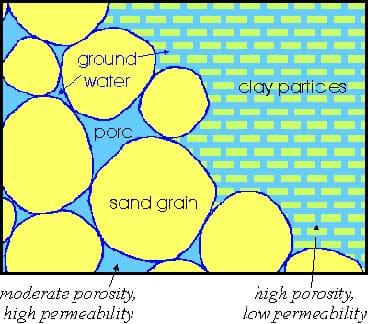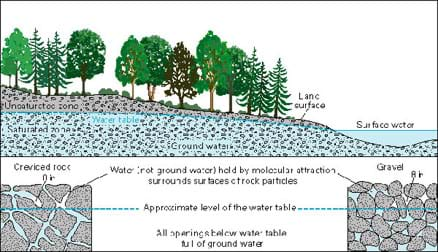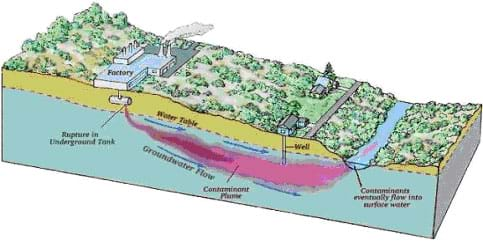Quick Look
Grade Level: 6 (5-7)
Time Required: 45 minutes
Lesson Dependency: None
Subject Areas: Earth and Space
NGSS Performance Expectations:

| MS-ESS2-4 |
Summary
Students learn how water flows through the ground, what an aquifer is, and what solid properties predict groundwater flow. Groundwater is one of the largest sources of drinking water, so environmental engineers need to understand groundwater flow in order to tap into this important resource. Environmental engineers also study groundwater to track the movement of pollution from the surface.Engineering Connection
Groundwater is an important source of drinking water in the world, and one that is at growing risk of becoming polluted by fertilizers, pesticides and industrial pollutants such as dry cleaning chemicals and dyes. Environmental engineers are challenged to clean the groundwater and restore it to a natural or usable state so that it remains free of harmful chemicals that could contaminate the drinking water supply and make people sick.
Learning Objectives
After this lesson, students should be able to:
- Describe groundwater as a useful water resource for drinking water.
- Understand how porosity and permeability relate to groundwater flow.
- Describe the role of engineers in the study of groundwater.
- Describe the cause and effect relationship of chemical pollution on groundwater resources.
Educational Standards
Each TeachEngineering lesson or activity is correlated to one or more K-12 science,
technology, engineering or math (STEM) educational standards.
All 100,000+ K-12 STEM standards covered in TeachEngineering are collected, maintained and packaged by the Achievement Standards Network (ASN),
a project of D2L (www.achievementstandards.org).
In the ASN, standards are hierarchically structured: first by source; e.g., by state; within source by type; e.g., science or mathematics;
within type by subtype, then by grade, etc.
Each TeachEngineering lesson or activity is correlated to one or more K-12 science, technology, engineering or math (STEM) educational standards.
All 100,000+ K-12 STEM standards covered in TeachEngineering are collected, maintained and packaged by the Achievement Standards Network (ASN), a project of D2L (www.achievementstandards.org).
In the ASN, standards are hierarchically structured: first by source; e.g., by state; within source by type; e.g., science or mathematics; within type by subtype, then by grade, etc.
NGSS: Next Generation Science Standards - Science
| NGSS Performance Expectation | ||
|---|---|---|
|
MS-ESS2-4. Develop a model to describe the cycling of water through Earth's systems driven by energy from the sun and the force of gravity. (Grades 6 - 8) Do you agree with this alignment? |
||
| Click to view other curriculum aligned to this Performance Expectation | ||
| This lesson focuses on the following Three Dimensional Learning aspects of NGSS: | ||
| Science & Engineering Practices | Disciplinary Core Ideas | Crosscutting Concepts |
| Develop a model to describe unobservable mechanisms. Alignment agreement: | Water continually cycles among land, ocean, and atmosphere via transpiration, evaporation, condensation and crystallization, and precipitation, as well as downhill flows on land. Alignment agreement: Global movements of water and its changes in form are propelled by sunlight and gravity.Alignment agreement: | Within a natural or designed system, the transfer of energy drives the motion and/or cycling of matter. Alignment agreement: |
Common Core State Standards - Math
-
Write, read, and evaluate expressions in which letters stand for numbers.
(Grade
6)
More Details
Do you agree with this alignment?
-
Fluently add, subtract, multiply, and divide multi-digit decimals using the standard algorithm for each operation.
(Grade
6)
More Details
Do you agree with this alignment?
International Technology and Engineering Educators Association - Technology
-
The management of waste produced by technological systems is an important societal issue.
(Grades
6 -
8)
More Details
Do you agree with this alignment?
-
Illustrate how systems thinking involves considering relationships between every part, as well as how the system interacts with the environment in which it is used.
(Grades
6 -
8)
More Details
Do you agree with this alignment?
State Standards
Colorado - Math
-
Use ratio and rate reasoning to solve real-world and mathematical problems.
(Grade
6)
More Details
Do you agree with this alignment?
Colorado - Science
-
Explain how the arrangement and motion of particles in a substance such as water determine its state
(Grade
6)
More Details
Do you agree with this alignment?
-
Identify problems, and propose solutions related to water quality, circulation, and distribution – both locally and worldwide
(Grade
6)
More Details
Do you agree with this alignment?
Pre-Req Knowledge
Some knowledge of multiplication and division.
Introduction/Motivation
Is there actually a river under the ground? In some sense yes, but it does not look like a river that we see outside. Water under the ground saturates the soil or dirt below the surface. It flows like a river, but very, very slowly. This slow moving water under the ground is called the groundwater.
All of the ground is made up of individual particles of soil — some tiny and some large. The spaces between particles are called pores. The measure of how much volume of pore space exists in specific soil is called porosity. The larger the pores, the more room for water to flow through the soil. Therefore, water flows through soils with high porosity more easily. Permeability measures how easily water flows through soil. Soils with high porosity have high permeability and soils with low porosity have low permeability. Porosity and permeability are used most often to determine how quickly and easily groundwater flows. Sometimes the water stores up in a large underground area, such as a lake; this is called an aquifer. Aquifers are often used as a water resource for drinking water.
Groundwater is a very important source of drinking water in the US and other parts of the world. It is also at risk of becoming polluted by a range of chemicals, including pesticides, fertilizers, dyes, pharmaceuticals (medicines), dry cleaning chemicals, spilled gasoline and paint, and other chemicals that are released by human activity. After the 1940s, production of these types of chemicals drastically increased, and they were used for many industrial and agriculatural processes. Unfortunately, many people did not know how bad the chemicals were and disposed of them irresponsibly: dumping chemical waste straight into rivers, streams, lagoons or anywhere convenient. The result of carelessly disposing of chemicals is a very toxic, very dangerous pollution that ultimately seeps through the ground into the groundwater. Environmental engineers are challenged to clean the groundwater and restore it to its natural or a usable state. They work to keep the groundwater free of harmful chemicals that could potentially get into a drinking water supply and make people sick.
Lesson Background and Concepts for Teachers
Water Cycle
For the most part, water is like energy: it is neither created nor destroyed. With the exception of a few chemical reactions that create and use water, most water cycles around the Earth simply change the form of the water. For example, one water droplet in New York can condense, become part of a cloud, and then fall from the sky as rain or snow in Chicago, IL. From Chicago it might travel through waterways down the entire length of the Mississippi River to the Gulf of Mexico and end up in the ocean for years. One day, it might evaporate and travel in the air; then, the cycle starts over again. Another water droplet could be sprayed from a sprinkler onto corn crops in Iowa, taken up and used by a corn plant, and transpired into the air again. If the same water droplet was not taken up by the corn, but instead filtered through the ground, it could become part of the groundwater and travel through the ground for thousands, even millions of years. Each water droplet has its own story, but the entire process (called the water cycle) is summarized as the following components: evaporation, transpiration, condensation and precipitation (see Figure 1).

Groundwater
A lot of water travels over the surface of the Earth, but we tend to forget about what we cannot see under the ground — the groundwater. Groundwater makes up about 90% of the useable fresh water on the Earth. It is a very important resource as well as a very important part of the water cycle. Groundwater interacts with surface water. Water can flow from a lake or stream into the ground, travel for miles underground, and then flow back into another lake or stream or be pumped out through a well. Lakes or streams that lose water to the groundwater are called losing streams or lakes, while lakes or streams that gain water from groundwater are called gaining streams or lakes. Refer to the associated activity Where Does All the Water Go? for students to learn the basic vocab associated to groundwater alongside a demonstration!
Porosity and Permeability
Soil is everything that collects on the surface of the Earth that is loose or unconsolidated. It is made up of little grains that can come from the weathering of rocks or minerals or the biodegradation of organic matter that has died, such as sea algae or tree and plant leaves. In addition, all soils have a little bit of water. Many different kinds of soils exist and each has a different composition of rock/mineral grains, organic matter and water. Some common types of soil are sand, gravel, silt and clay.

Each of these soil types is different due to different grain sizes, as illustrated in Figure 2. Sand has the largest grains and clay has the smallest grains. Small grains can be packed very tightly, whereas large grains cannot be packed as tightly. For example, if you were to fill your classroom with balls, could you fit more bowling balls in the classroom or more golf balls in the classroom? You could fit more golf balls, because they are smaller and can be more tightly packed together. The spaces between the grains are called pores. Soils with larger grains have larger pores and vice versa. The measure of how much pore space a specific soil has is called porosity. The mathematical definition is:

The larger the pores, the more room there is for water to flow through the soil. Therefore, water flows through soils with high porosity more easily. Permeability measures how easily water flows through soil. Soils with high porosity have high permeability, and soils with low porosity have low permeability. Porosity and permeability are used most often to determine how quickly and easily groundwater flows. Refer to the associated activity How Full Is Full? for students to learn about porosity and permeability and relate these concepts to groundwater flow.
Groundwater Flow
Although it is slow, water normally flows through the ground. How much water flows through the ground, or the groundwater velocity (v), is determined by Darcy's law. Darcy's law can be written as follows.
v = kl
The groundwater flow rate is controlled by hydraulic conductivity (k) and the hydraulic gradient (I). Hydraulic conductivity is a direct measure of the permeability and porosity of the soil (that is, if the soil has a high porosity, then it has a high permeability and, thus, a high hydraulic conductivity and flow rate). The hydraulic gradient is dependent on the change of elevation. Consider a mountain with one side that is very steep and one side that is gently sloping; would water flow faster down the steep side or the gently sloping side? (Answer: It would flow down the steep side faster.) Groundwater flows just like surface water — it generally flows from an area of high elevation to a lower elevation. The steeper the change in elevation, the quicker the water flows. Hydraulic gradient measures the change in groundwater elevation (that is, the steepness of the slope).
What is an Aquifer?
An aquifer is a permeable layer of rock or soil that is saturated with water. Technically, an aquifer must be able to yield useable amounts of water when pumped. Most aquifers are soils such as sand or gravel that become filled with water. The level that the water raises to is called the water table. Two different types of aquifers exist: confined and unconfined. Confined aquifers are "pressurized" by impermeable layers of rock or soil called confining layers above and below the aquifer. Because water cannot flow through a confining layer, the aquifer acts like a pipe: the water is under pressure and flows faster. In an unconfined aquifer, the water is not confined by anything and the water level — or water table — can move up and down. Below the water table, all the pores in the soil are filled with water, or are saturated. This is called the saturated zone. Above the water table is soil that is not saturated with water; this is called the unsaturated zone or vadose zone. See Figure 3 for a visual illustration of the layers of an aquifer.

Groundwater Pollution
When it rains, water is filtered through the unsaturated zone and ends up in the groundwater. Once it is in the groundwater, it can travel far distances under the ground, until it reaches a well. There, it remains until someone pumps it for drinking water or irrigation use. Unfortunately, this is how aquifers and groundwater become polluted. For example, if someone spills gasoline on the road, it will eventually end up in the groundwater. On average, groundwater moves very slowly, around 0.01 to 0.000001 cm/s (that is on the order of feet per day). Because groundwater moves so slowly, pollutants create plumes, or areas of contaminated groundwater. Imagine what would happen if you poured a lot of food coloring into a lake: would it all stay right where you poured it? No, it would spread out and eventually become diluted in the lake. Pollutants such as gasoline behave in a similar way when they seep into groundwater: when spilled, they can contaminate the groundwater, then be pumped up from wells, and end up in your drinking water (see Figure 4).

Associated Activities
- Where Does All the Water Go? - Students learn the vocabulary associated with groundwater and see a demonstration of groundwater flow. They learn about the measurements that environmental engineers need when creating groundwater models of chemical plumes.
- How Full is Full? - Students learn about porosity and permeability and relate these concepts to groundwater flow. They use simple materials to conduct a porosity experiment and use the information to understand how environmental engineers decide on the placement and treatment of drinking water wells.
Lesson Closure
What sort of things do engineers do to protect our underground water supplies? (Listen to student answers.) Engineers help locate aquifers for water use and monitor any pollutants that may enter the aquifer.
Who can describe "porosity" for me? Who can describe "permeability" for me? How are they related? (Answer: Things that have higher porosity also have high permeability, and permeability is related to groundwater flow.)
Would aquifers containing soils with high permeability have higher or lower flow rates? (Answer: Higher flow rates.) Aquifers with higher flow rates are able to provide more water for drinking and other purposes. But what happens if pollutants get into an aquifer with a high flow rate? (Listen to student ideas) Higher flow rates can also mean pollution spreads quickly and easily throughout that aquifer.
Vocabulary/Definitions
aquifer: Water saturated layers of soil or rock that yields a useable amount of water when pumped.
condensation: The process of water changing from gas to liquid phase.
confined aquifer: An aquifer that is bordered by two impermeable confining layers; it is under pressure.
confining layer: The layer of impermeable rock or soil that confines an aquifer.
Darcy's law: The governing equation from groundwater flow. It is equal to Q = kI, where k is the hydraulic conductivity related to the permeability and I is the hydraulic gradient.
evaporation: The process of water changing from liquid to gas phase.
gaining stream: A stream that gains water from the groundwater.
groundwater: Water under the ground often found in permeable layers of rock or soil.
losing stream: A stream that looses water to the groundwater.
permeability: A measure of how easily water flows through soil; used to calculate hydraulic conductivity (k).
porosity: A measure of how many pores are in a soil. Porosity is equal to the volume of pore divided by the total volume of soil.
precipitation: Water that falls from the sky as rain, snow, sleet or hail.
saturated zone: The zone under ground that is completely saturated with water.
transpiration: When water is taken up through a plant (from the roots through the stem and out the leaves) and evaporated into the atmosphere.
unconfined aquifer: An aquifer that is open to the atmosphere; the water level can change; it is not under pressure.
vadose zone: Also know as the unsaturated zone; it is under ground, but above the water table; it is not saturated with water.
water cycle: The process of evaporation, condensation, transpiration and precipitation.
water table: The line between the saturated zone and the vadose (unsaturated) zone.
Assessment
Pre-Lesson Assessment
Discussion: Ask students the following questions and encourage them to come up with several answers. Tell them that there is no right answer. Explain to the students that they can talk freely, but have to talk one at a time. If they cannot talk one at a time, then have them raise their hands to answer. Record their answers on the board.
- Where do you think we get our drinking water? (Possible answers: reservoirs, lakes, rivers, streams, wells and groundwater.)
Post-Introduction Assessment
Question and Answer: Ask the students the following questions.
- What is groundwater? (Answer: Water located under the ground.)
- How could groundwater become polluted? (Possible answer: Pollutants on the ground surface can seep through the ground into the groundwater.)
- How do we use groundwater? (Answer: Groundwater is a major source of drinking water.)
- How fast does groundwater move? (Answer: Slowly)
- If the soil has a hydraulic conductivity of 1x10-5 m/s, and the hydraulic gradient is 2.5 m/m, how fast is the groundwater moving? (Answer: 2.5x10-5 m/s or 2.16 meters per day!)
- What different things pollute the groundwater? (Possible answers: chemicals such as chlorinated solvents [such as TCE, PCE and PCP], fertilizers [such as nitrate] and pesticides [such as DDT].)
- What is an aquifer? (Answer: Water stored in permeable rock and soil that produces a useable amount of water when pumped.)
- What do engineers have to do with groundwater? (Possible answers: Environmental engineers are challenged to keep groundwater unpolluted and, if polluted, restore it to its natural or a usable state; they aim to keep the groundwater free of harmful chemicals that could potentially get into a drinking water supply and make people sick.)
Lesson Summary Assessment
Letter to the Mayor: A textile industry once owned a factory on a hill outside of Happy Town. It is known that various chlorinated chemicals were dumped into an unlined lagoon next to the factory from when they opened in 1955 until they went bankrupt in 1980. The town does not consider this lagoon to be a risk, but GR Water Engineering Consultants, who employs the students, did some tests and found out that the local water table is really shallow. The groundwater is flowing from the lagoon toward the town well. Have students write a persuasive letter to the Mayor of Happy Town explaining the danger of their town's groundwater supply becoming polluted.
Require that the letters describe how groundwater flows and how long it might take until the water supply becomes polluted. Give students the following facts.
- The groundwater is flowing from east to west.
- The lagoon is directly east of the town's well.
- The groundwater is flowing 0.5 miles/year.
- The lagoon is approximately 25 miles from the town well.
(Answer: At this rate, the pollution would reach the town in 50 years. It would start entering the town's water supply in approximately 2005 and continue to do so for another 25 years.)
Lesson Extension Activities
Have students find and research a chemical that could pollute the groundwater. Have them bring in a list of chemicals that they think may be harmful to humans. Suggest that they look at ingredients in household cleaners or search on the internet. Then, at school the next day, have them research the list of chemicals at https://www.epa.gov/iris. Assign students to pick one chemical they found on either website and write a paragraph about its toxic effects. Include a description of the negative health effects it causes, and how it causes those effects (for example, is it more toxic if inhaled or ingested).
Subscribe
Get the inside scoop on all things TeachEngineering such as new site features, curriculum updates, video releases, and more by signing up for our newsletter!More Curriculum Like This

Students learn the vocabulary associated with groundwater and see a demonstration of groundwater flow. Students learn about the measurements that environmental engineers need when creating a groundwater model of a chemical plume.

Students learn about porosity and permeability and relate these concepts to groundwater flow. They use simple materials to conduct a porosity experiment and use the data to understand how environmental engineers decide on the placement and treatment of a drinking water well.

Students learn about several possible scenarios of contamination to drinking water, which comes from many different sources, including surface water and groundwater. They analyze the movement of sample contaminants through groundwater, in a similar way to how environmental engineers analyze the phys...

Students learn about physical models of groundwater and how environmental engineers determine possible sites for drinking water wells. Students create their own groundwater well models using coffee cans and wire screening. They add red food coloring to their models to see how pollutants can migrate ...
References
Department of Health and Human Services, Agency for Toxic Substances and Disease Registry, ATSDR Information Center. Accessed October 13, 2005. https://www.atsdr.cdc.gov/toxicsubstances.html
U.S. Department of the Interior, USGS, Water Science for Schools, Earth's Water: Groundwater. Accessed October 13, 2005. http://ga.water.usgs.gov/edu/earthgw.html
U.S. Environmental Protection Agency, Office of Research and Development, National Center for Environmental Assessment, IRIS Integrated Risk Information System. Accessed October 13, 2005. https://www.epa.gov/iris/
Copyright
© 2005 by Regents of the University of Colorado.Contributors
Malinda Schaefer Zarske; Janet Yowell; Melissa StratenSupporting Program
Integrated Teaching and Learning Program, College of Engineering, University of Colorado BoulderAcknowledgements
The contents of this digital library curriculum were developed under a grant from the Fund for the Improvement of Postsecondary Education (FIPSE), U.S. Department of Education and National Science Foundation GK-12 grant no. 0338326. However, these contents do not necessarily represent the policies of the Department of Education or National Science Foundation, and you should not assume endorsement by the federal government.
Last modified: July 3, 2025










User Comments & Tips